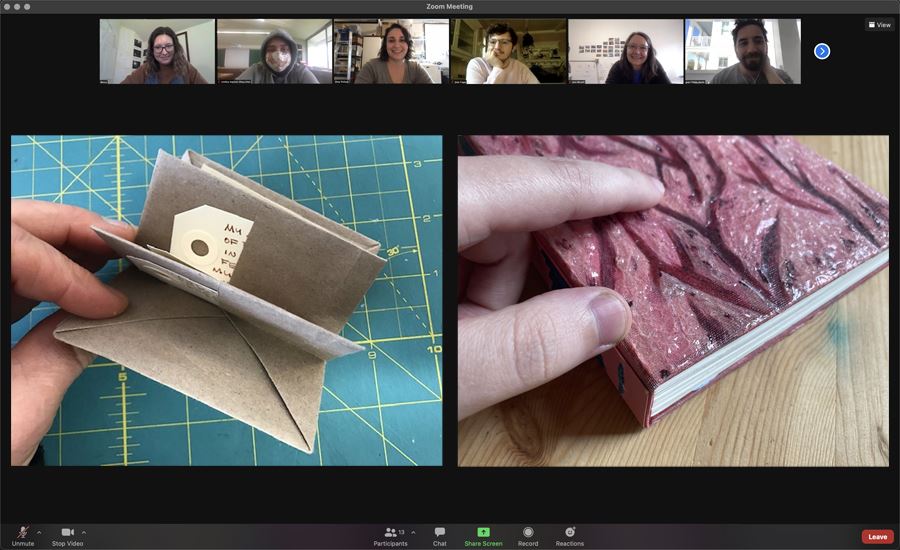
Do you think an artist’s book can exist solely in a digital space, or does it need a haptic component in order to be an artist’s book? What are the essential haptic qualities of a book you can’t live without?
As graduate students from the Mills College Book Art program, our curiosity led us to ask these questions to people within the book art ecosystem. Emails went to poets, book artists, letterpress printers, book designers, professors, collectors, theorists, gallerists, and librarians.
"My gut says no because I love the touch and feel of a book that has the evidence of the human hands in the making, in the turning of the page, all the things that make a book, that make us unique as human beings.” —Truong Tran
“I think an artist's book can be created in a digital medium instead of a [three dimensional] one, so then to read that book is to engage with it in a digital realm. And a digital artist book can do things a physical codex cannot, they operate under different rules and limitations.… [But] taking away the haptic component of art... cuts one's physical experience of the book off at the knees and some meaning is lost in the digital translation.” —Brooke Hardy
“I do believe an artist's book can inhabit only a digital realm. It all depends on the outcome the artist wants the user to have and if it's the most effective method to do so.“ —James Tucker
“Haptic qualities I can't live without is flipping the pages of a good book and looking for all the highlights and reading them.… I think some books can solely exist in digital space like books that have limited texture or are simply print and paper. But books that have special formats like pop ups, wonderful texture or special binding, I think those would be hard to appreciate in a digital form.” —Amber McCrary
“While I think it is possible for artist booklike forms to exist in a digital space, I do believe that with the loss of the full haptic experience, the tradeoff is a certain loss of attention. This is a difficulty not only in times of quarantine, but in in-person exhibitions where artist books are frequently shown in vitrines or cases.... The haptic experience of the book is the romance, to touch, to hold.... I believe the connection the viewer experiences with this vulnerability ... is part of what instills the sense of wonder in the viewer. Does work that necessitates a haptic experience still matter today? Hell yes. Is it difficult to exhibit? Also yes.” —Michelle Wilson
“Touch, textural contrasts & the ability to play with scale are big qualities I would miss, but I feel like it would present a fun challenge to try to explore those things in a digital space.” —e bond
“...[R]ules are made to be broken, so if I say no, then someone very smart will do something in the digital realm that would prove me wrong.… I am interested in hand skills and the way we interact with and manipulate materials that we learn to know intimately through practice and experience. The object then embodies that human experience.… For me, the most essential haptic quality of a book is the feel of the paper as you turn the page. The type of paper, the binding, whether the paper is folded or loose, the grain, what the printing and the ink has done to that paper, all affect the experience of turning the page.” —Joel Benson
“I typically suggest that students view [book] documentation, particularly the videos, as alternative artist’s books or a different iteration of their book. To experiment ... can free the artist and give them a different understanding of [their] relationship to their work....
"While I love the tactility and deep connection made possible with an artist’s book, books are more than that. Just as my experience of a book can be enriched and may be even enlivened by experiencing the audiobook version, I expect an artist’s book in the digital space could excite my sense.” —Tia Blassingame
“...[Y]es, I believe an artist's book can exist solely in a digital space. Would I like it? That's another question.… I think more than haptic, an essential quality of an artist's book is the ability to unveil a unique, layered, and oftentimes embodied reading experience.” —Inge Bruggman
“Let’s start with the proposition that not everything has to be a book.... You are free to call anything by any word or sound—language is not a fixed condition, but a continually evolving process of creating meaning using context to orient communication.... Haptics are often cited as a missing element in digital work, but I argue that since we experience all digital media through some kind of physical device, there are always haptics included in the experience of a digital work.... Screen life [...] is an impoverished sensorium, limited to just sound and low-ish rez [...] color space. Real life is so much richer.” —Clif Meador
“Heft turns out to be central, along with page manipulation and the ability to scribble marginalia.… While I am not willing to say that a digital native artist’s book isn’t possible, I have yet to see any example that is at all persuasive.” —Kathy Walkup
“a book is a book is a book is a book.” —Yo Cuomo
Joel Benson, Dependable Letterpress. Tia Blassingame, Scripps College Press and Primrose Press. e bond, Artist/Book Binder. Inge Bruggeman, University of Nevada, Reno and INK-A! Press. Yo Cuomo, Book Designer. Brooke Hardy, Book Artist. Amber McCrary, Abalone Mountain Press. Clif Meador, Appalachian State University and Book Artist. Truong Tran, Poet and Artist. James Tucker, Aesthetic Union. Kathy Walkup, Director, Mills Book Art Program. Michelle Wilson, Rocinante Press.

